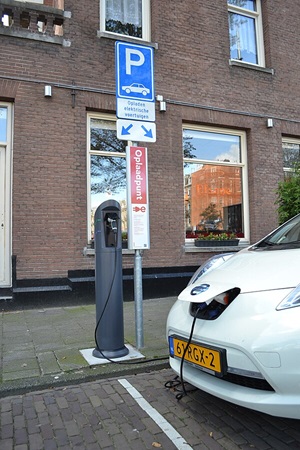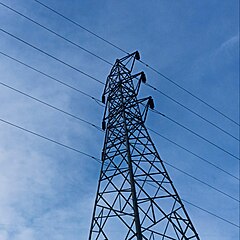Bidirectional charging, or possible charging from both sides, is a smart solution for grid overcharging. Bidirectional charging means that the current can go both ways. It is useful in particular for preventing the grid to become congested. Or if one has an electric car. The car can be charged, and the current can go the other way as well: from car to home or the grid. A good solution for peak moments.

Overcharged grid
Kaz Schonebeek treats the problem on the site change.inc (in Dutch). The grid is being overcharged, it cannot carry any additional load, at least not during peak moments. And yet, the grid is being charged on average by just 30%; also in the Netherlands with its busy infrastructure. Bidirectional charging will offer a solution. On the one hand, customers can postpone the moment of charging electric cars; on the other hand, these cars can deliver electricity when demand is high.
The first models that can charge bidirectionally come to the market now. But yet there are technical hurdles that need to be overcome. Among others, car maker Kia deals with these problems, as well as ElaadNL, a Dutch innovation centre for smart charging techniques, founded by grid companies.
Grid congestion
Grid congestion arises when the electricity grid is overcrowded. For instance because, at times, solar panels and wind turbines produce electricity when there is no demand, and vice versa. Demand itself is on the rise, because the number of electric appliances like heat pumps and electric cars is growing. These can contribute to solving grid congestion by not charging as there is much demand; for instance early in the evening, when people arrive at home from their work. Redelivery is a new option, that could facilitate the prevention of blockage on the grid.
Redelivery should happen at the right time. The precise determination of that moment will involve many parties. Of course, the car; also the point of charge; the back office that determines when the car charges, and discharges; the energy provider and the grid manager. Thet need to communicate with each other through protocols: arrangements on how information is being distributed, for instance on grid tariffs; or on how much the battery is charged. But partly, such protocols still need to be developed and standardized.
Realtime information
The information shared in this way should be realtime. Most importantly for determining at what time electricity needs to be fed back. And of course, the compensation for feeding back electricity needs to reflect if this has been fed back at the right moment. Not an easy task. It may be sunny in one spot, and rainy just a few miles further down the road. Cars with a bidirectional feeding facility could prevent imbalance – but in order to determine that, we need a good data supply.
We also need such a data supply in order to show customers what they could earn, using realtime information. They can earn money by charging or discharging at the right moment. But displaying the correct information – that might be a point of concern.

Societal importance
There is much societal importance in the breakthrough of bidirectional charging. Companies in the Netherlands are being confronted already with the fully used electricity grid. In some areas, new housing construction isn’t even possible because the grid would become overcharged. Smart charging allows for more room on the grid already; bidirectional charging adds to that. But determining the price of electricity hasn’t been tuned to these opportunities yet; and moreover, there is no adequate remuneration of recharging electricity to the grid, when required. We conclude that we need to adapt rules and tariffs to the new situation.
In short, we should have a keen eye on the opportunities offered by the electric motor car. Bidirectional charging is the solution. Smart charging will provide a win-win situation to all parties participating. Motor car drivers will receive cheaper electricity and will be able to use more solar power of their own; grid owners will be offered solutions for grid congestion; energy companies will be better placed to tune supply and demand. Right now, the moment of plugging in the charging cable will determine the tariff you pay. We would have to change that. The motor car can better be charged at 2 o’clock at night than as the driver arrives home. In other words, arrive at 6 o’clock and plug in the cable, but charging only at 2 o’clock at night.
The advantages
To the energy sector, bidirectional charging will offer many opportunities. For instance, one could charge as the sun shines fiercely, or as there is a lot of wind. That would offer advantages to both motor car driver and green electricity producer, for the latter will get a better price for his product. And one will take care of proper use of renewable electricity, it will not be thrown away. Now it often happens that solar parks and wind turbines are being shut off from the grid, in order to prevent overcharging.
In other words, bidirectional charging will offer benefits to all sides. It will allow for better use of the grid and prevent imbalances; and the customer will benefit. If motor cars are being connected virtually, they will act as a kind of power station. A power station that one could turn on and off, as need be on the electricity market. The problem is that at present, grid management tariffs do not reflect this kind of services. They are the subject of negotiations going on.
We need to measure such services
And then, there are solar panels, that customers can use in order to charge their electric vehicle. Another area where data are insufficiently available. The software guesses the proceeds of the panels, based on their orientation and the weather pattern. The range of possibilities (including reverse charging) is even larger if there are not just solar panels, but also a home battery and a heat pump. This adds to the necessity to measure alle services rendered, so that these can be taken into account by the electricity company. The smart user might even install a Home Energy Management System. A system that will promote the use of energy produced at home.
The opportunities multiply if not just the home but also the car can charge bidirectionally. In other words: if cars can feed into the grid. They then become an integral part of the grid. In the ideal case, they will prevent the need for stronger connections. It takes years before stronger connections can be built: this implies the construction of new high voltage lines, that require an lengthy planning period. All kinds of social processes may be hindered by such procedures, even the connection to newly constructed homes.
The benefits of bidirectional charging
Fortunately, there are intermediate solutions, like battery storage. But in the end, we need to use the existing infrastructure more efficiently. Motor cars with the facility of bidirectional charging are an important link in this chain. They are going to be an important buffer in the grid. But also for this opportunity, we need to overcome obstacles. For most electric cars can change the grid alternating current to direct current, but not the other way around. But some cars, like the Kia EV9, now have such a transformer. This will allow us – if proper equipment and codes are in place – to transport electricity back into the grid. A gamechanger. This is particularly important for the prevention of peak charges. For instance by electric cars that would like to charge all at once.
We still need to develop the perfect system. It should be surveyable for the customer. And the financial consequences of the choices should be clear. For many, this is an exciting and fun business; but in the end, the result should be proper compensation.
Interested? Then also read:
Energy storage will accelerate the transition
Local optimization, against congestion on the grid
The overcrowded electricity grid
